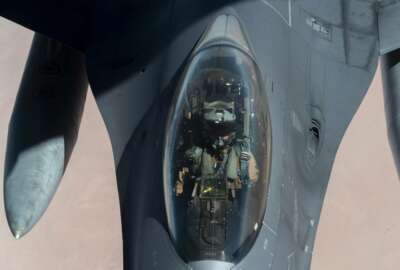
Air Force creates new office to settle internal ‘squabbles’ over ABMS
Air Force Secretary Frank Kendall says the new position — the PEO for Command, Control, Communications and Battle Management — is the "hardest acquisition job...
Best listening experience is on Chrome, Firefox or Safari. Subscribe to Federal Drive’s daily audio interviews on Apple Podcasts or PodcastOne.
The Air Force is setting up a new management structure to ride herd over its Advanced Battle Management System (ABMS), the Air Force’s contribution to the Pentagon’s Joint All-Domain Command and Control (JADC2) project. Officials say ABMS has demonstrated progress in some key technical areas, but those advancements haven’t always been coordinated with one another.
At the top of the new management structure for what Air Force officials have previously termed the “internet of military things” will be a brand new program executive office: The Air Force calls it the PEO for Command, Control, Communications and Battle Management, or PEO-C3BM.
Officials also announced Monday that Brig. Gen. Luke Cropsey will lead the new office. He’s currently the director of security assistance and cooperation programs at the Air Force Lifecycle Management Center, and has spent most of his career in acquisition and systems engineering jobs.
Frank Kendall, the secretary of the Air Force, told reporters Monday the main motivation for creating the new post is what he and other senior leaders see as a lack of integration across the ambitious and extremely complicated ABMS project.
“The observation was that the whole area of command, control, communications and battle management modernization needed centralized leadership on the technical side,” he said. “A lot of work had been done — some of that by the Joint Staff, some of it by our operational staff, some of it under the ABMS umbrella, but it hadn’t all been pulled together and it hadn’t been focused or integrated enough.”
Kendall said part of his thinking about the need for a new, highly-empowered leader to coordinate the service’s battle management efforts came from his experience as DoD’s top acquisition official during the Obama administration.
During that period as undersecretary for acquisition, technology and logistics, Kendall published annual reports on the performance of the Defense acquisition system. One key finding was that historically, acquisition programs for military command, control and communications were the ones most likely to fail or get cancelled.
“The reason they’re unsuccessful is that they’re broad, they require interface control across partners who may not want to change to accommodate each other, and they’re very complicated,” he said. “Often, people will start with very visionary ambitions about what they want, without having thought through what it’s really going to take to get there. And then when you start down that path, you get into all sorts of trouble. You have schedule problems, you have cost problems, you have performance problems. Eventually, programs like that die, and I don’t want that to happen here. The way to avoid that is to put somebody in charge … Luke will be that authority. He will also have system engineering responsibilities for the entirety of our C3 battle management for both the Air and Space Forces. He’s going to be the glue that ties it all together.”
The idea that ABMS needs more centralized management attention isn’t exactly new. The Government Accountability Office warned as early as April 2020 that the enterprise was on a risky footing, partly because of unclear decision making authorities.
The Air Force itself has recognized the management challenges too. In November of that same year, the service assigned its Rapid Capabilities Office as the “integrating PEO” for ABMS, the exact same verbiage the service used Monday in announcing the new C3BM PEO.
But officials say the new office will build on a “strong foundation” the Rapid Capabilities Office laid. And Kendall said PEO-C3BM will hold quarterly briefings with both him and Air Force Chief of Staff C.Q. Brown, who will make it clear to the rest of the Air Force that Gen. Cropsey’s directions need to be taken seriously.
“It’s a big job,” Kendall said. “When I talked to him the other day, I said, ‘Look, I’m about to give you the hardest acquisition job I’ve ever given anybody.’ And that’s what it is. It’s complicated. There are a lot of players in the game, and getting everybody aligned is really a tough job, but we’ve got to do it. And we’re going to give him the top-down support he needs. We’re going to help him enforce the decisions that he wants to make and get everybody aligned. Quite frankly, if we don’t do that, I think we’re just going to end up in all kinds of squabbles internally. That’s the traditional path for programs like this, and we don’t want that to happen.”
Another change as part of the reorganization: the Air Force is moving the staff and funding of its current chief architect’s office into the new PEO. The chief architect position was vacated earlier this year when Preston Dunlap departed government service. The Air Force plans to recreate something similar to the new position soon, when it announces a new chief of engineering within the new battle management office.
But even if the reorganization proves successful, it’s only part of the ongoing challenge to the Pentagon’s bigger JADC-2 project. To make the whole thing work, it’s not just the Air Force’s engineering efforts that’ll need to be synchronized, but the other services too.
Kendall said he’s at least reasonably optimistic the department can achieve the goal under a recent decision by Deputy Defense Secretary Kathleen Hicks, which gave DoD’s chief digital and artificial intelligence officer an oversight and management role over JADC-2.
“I think we’re all aligned on the intent. I think what the deputy has tried to do by bringing in the new CDAO, [Craig Martell] is to do something similar to what I’m trying to do with Luke Cropsy: It’s to have someone that can be her focal point to try to bring everybody together,” he said. “I’ve had a conversation with the CDAO, and it was very good conversation. Luke will be working closely with him and with others. So I think it’s a work in progress, but I think we’re moving in the right direction.”
Copyright © 2025 Federal News Network. All rights reserved. This website is not intended for users located within the European Economic Area.
Jared Serbu is deputy editor of Federal News Network and reports on the Defense Department’s contracting, legislative, workforce and IT issues.
Follow @jserbuWFED
Related Stories





